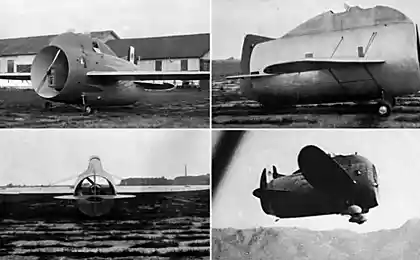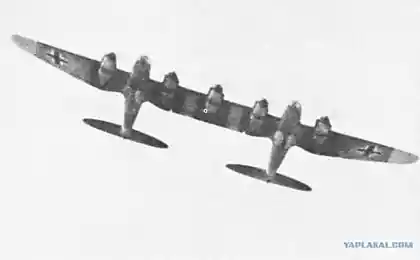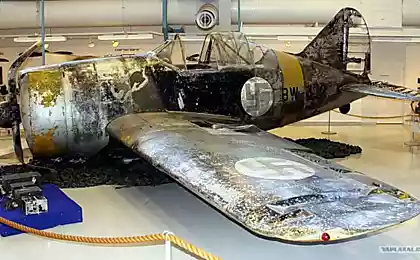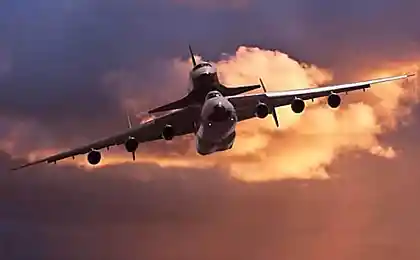724
The plane with a nuclear reactor
In the late 40's - early 50-ies in the USSR in the laboratory instrumentation Academy of Sciences (Laboratory №2) under the leadership of Kurchatov turned a study on the establishment of nuclear reactors for ship power plants. Soon the work started in the use of nuclear energy in aviation. Leaders in the aviation-themed Kurchatov Institute was entrusted to academician AP Aleksandrov.
August 12, 1955 the Resolution of the Council of Ministers, in which a nuclear aircraft category were connected some enterprises of the aviation industry. OKB Tupolev-156, DB-23 and DB-VM Myasischev 301 Lavochkin had to do the design and construction of aircraft with nuclear power units (SU), and OKB-276 ND Kuznetsov's OKB-165 A.M.Lyulki development of SU. Creating a nuclear aircraft SU Air Force opened up the opportunity to get their hands on manned military complexes with unlimited duration and range. It is considering several options for the nuclear power plants of aircraft on the basis of direct-flow, turbojet and turboprop engines with different schemes of heat transfer to the engine. Perfected various types of reactors and heat transfer systems: air and liquid metal with intermediate cooling, thermal and fast neutrons, etc. Considered acceptable for use in aircraft types of biological protection of the crew and equipment systems from the effects of radiation.
The Lavochkin design bureau and A.M.Lyulki worked on the project of a cruise missile based on "The Tempest" nuclear propulsive jet engine, designed in OKB V. Myasishev strategic bomber.
The Tupolev Design Bureau in cooperation with related organizations, has worked out a large-scale, designed for two decades, the program of creation and development of heavy combat aircraft with nuclear power plants. She had completed the construction of 70-80 years full combat subsonic and supersonic aircraft for various purposes. The first phase was supposed to create the ground stand for testing airborne nuclear power plant, then a similar installation was to be tested in a flying laboratory with the aim of improving the system of radiation protection of the crew.
March 28, 1956 the Resolution of the USSR, according to which KB started practical work on the design of a flying laboratory on the basis of serial Tu-95 for studies of the effect of radiation on nuclear reactor aviation aircraft equipment, as well as to explore issues related to radiation protection of the crew and Operating characteristics of the aircraft with a nuclear reactor on board.
Design work on the ground test bench and installation of the reactor on the aircraft were carried out in Tomilino branch OKB, headed I.F.Nezvalem. The stand was created on the basis of the middle part of the fuselage of the Tu-95. Radiation protection at the stand, and then on the flying laboratory, received the designation Tu-95LAL (Order 247), manufactured using a completely new aviation materials. For development in the production of these materials it required a completely new technology. They have been successfully utilized in the department of non-metals OKB led A.S.Faynshteyna. New defensive aviation materials and design elements were created in collaboration with experts of chemical industry, nuclear scientists tested and found suitable for use in ground installations and flying laboratory.
In 1958, ground stand was built and taken into halves - the so-called experimental basis at one of the airports near Semipalatinsk. At the same time it has been prepared for a nuclear power plant flying laboratory. At the booth and flying laboratory reactor was mounted on a special platform with a lift for ease of maintenance. If necessary, he could fall out of the aircraft gruzootseke.
In the first half of 1959 it was made the first run of the reactor on the ground stand. During ground tests managed to reach a predetermined level of reactor power. There was a great experience working with the reactor. It tested the reactor control devices and monitoring radiation shielding protection system, made recommendations to the crew. Now you can move on to work on the flying laboratory.
Under the flying laboratory Tu-95LAL was converted serial Tu-95M № 7800408. From May to August 1961 at the flying laboratory was carried out 34 flight. On Tu-95LAL flying and tests the test pilots M.M.Nyuhtikov, E.A.Goryunov, M.A.Zhila et al., A leading Vehicle was N.V.Lashkevich. The flight tests of the experiment was attended by the head of N.Ponomarev-steppe and operator V.Mordashev. Investigations of the radiation situation in the cockpit and behind the physics carried V.Madeev and S.Korolev. The flight is like a cold reactor and is running. These flights are mainly tested the effectiveness of biological protection.
Design features. The crew and the experimenters were in front of hermetically sealed cabin, where there was a sensor fixing radiation. For cabin was installed protective screen of lead and combined materials. In gruzootseke area where the future should be located combat load, a second sensor was installed. A third sensor located at the rear of the cockpit. Two sensors mounted under the wing panels in suspended tamperproof containers. All probes were swivel vertically. In the middle part of the fuselage was located compartment with water-water reactor with a powerful protective shell.
Compartment bit out of the fuselage of the aircraft and was covered with metal fairing on top, bottom and sides of the fuselage. Under the compartment was a large intake air cooler water loop reactor. On board there was a reactor control system is connected to the console experimenters.
Flight tests Tu-95LAL showed enough high efficiency of the system of radiation protection, which made it possible to continue to work on aircraft with nuclear power plants. But soon after that all work on the nuclear aircraft category were stopped due to financial constraints. At the same time, the Soviet Union deployed the program of building nuclear submarines, intercontinental ballistic missiles, ground-based. To a certain extent also feared a possible nuclear accident aircraft that can cause contamination of large areas of nuclear components. Tested at this stage of biological protection and even appeared robust but still bulky and heavy for use in aviation and require further work in this direction.
The next important stage in the creation of a nuclear aircraft SU was to become the Tu-119 with boosters, adapted to work with a nuclear reactor. By the time Americans experienced a flying laboratory with a nuclear power plant based on B-36 performed similarly Tu-95LAL practically turned its further work in this area. Catch up with was in this respect no one, but go ahead too expensive and dangerous.
Sources of information
1. M. Rebrov Legends were a "sign" or the history of the atomic bomber // Krasnaya Zvezda, 1993, July 7, p.2.
2. B. Under Rigmant signs "ANT" and "TU". "119" (Tu-119) // Aviation and Astronautics, 1999, №7.
3. Rigmant V. Tu-95 // Aerospace 2001, №2.
4. Photographs from the collection of the author.
taken from here: vfk1.narod.ru/Tu-95LAL.htm
forgotten pictures ...

another ...

Source:
August 12, 1955 the Resolution of the Council of Ministers, in which a nuclear aircraft category were connected some enterprises of the aviation industry. OKB Tupolev-156, DB-23 and DB-VM Myasischev 301 Lavochkin had to do the design and construction of aircraft with nuclear power units (SU), and OKB-276 ND Kuznetsov's OKB-165 A.M.Lyulki development of SU. Creating a nuclear aircraft SU Air Force opened up the opportunity to get their hands on manned military complexes with unlimited duration and range. It is considering several options for the nuclear power plants of aircraft on the basis of direct-flow, turbojet and turboprop engines with different schemes of heat transfer to the engine. Perfected various types of reactors and heat transfer systems: air and liquid metal with intermediate cooling, thermal and fast neutrons, etc. Considered acceptable for use in aircraft types of biological protection of the crew and equipment systems from the effects of radiation.
The Lavochkin design bureau and A.M.Lyulki worked on the project of a cruise missile based on "The Tempest" nuclear propulsive jet engine, designed in OKB V. Myasishev strategic bomber.
The Tupolev Design Bureau in cooperation with related organizations, has worked out a large-scale, designed for two decades, the program of creation and development of heavy combat aircraft with nuclear power plants. She had completed the construction of 70-80 years full combat subsonic and supersonic aircraft for various purposes. The first phase was supposed to create the ground stand for testing airborne nuclear power plant, then a similar installation was to be tested in a flying laboratory with the aim of improving the system of radiation protection of the crew.
March 28, 1956 the Resolution of the USSR, according to which KB started practical work on the design of a flying laboratory on the basis of serial Tu-95 for studies of the effect of radiation on nuclear reactor aviation aircraft equipment, as well as to explore issues related to radiation protection of the crew and Operating characteristics of the aircraft with a nuclear reactor on board.
Design work on the ground test bench and installation of the reactor on the aircraft were carried out in Tomilino branch OKB, headed I.F.Nezvalem. The stand was created on the basis of the middle part of the fuselage of the Tu-95. Radiation protection at the stand, and then on the flying laboratory, received the designation Tu-95LAL (Order 247), manufactured using a completely new aviation materials. For development in the production of these materials it required a completely new technology. They have been successfully utilized in the department of non-metals OKB led A.S.Faynshteyna. New defensive aviation materials and design elements were created in collaboration with experts of chemical industry, nuclear scientists tested and found suitable for use in ground installations and flying laboratory.
In 1958, ground stand was built and taken into halves - the so-called experimental basis at one of the airports near Semipalatinsk. At the same time it has been prepared for a nuclear power plant flying laboratory. At the booth and flying laboratory reactor was mounted on a special platform with a lift for ease of maintenance. If necessary, he could fall out of the aircraft gruzootseke.
In the first half of 1959 it was made the first run of the reactor on the ground stand. During ground tests managed to reach a predetermined level of reactor power. There was a great experience working with the reactor. It tested the reactor control devices and monitoring radiation shielding protection system, made recommendations to the crew. Now you can move on to work on the flying laboratory.
Under the flying laboratory Tu-95LAL was converted serial Tu-95M № 7800408. From May to August 1961 at the flying laboratory was carried out 34 flight. On Tu-95LAL flying and tests the test pilots M.M.Nyuhtikov, E.A.Goryunov, M.A.Zhila et al., A leading Vehicle was N.V.Lashkevich. The flight tests of the experiment was attended by the head of N.Ponomarev-steppe and operator V.Mordashev. Investigations of the radiation situation in the cockpit and behind the physics carried V.Madeev and S.Korolev. The flight is like a cold reactor and is running. These flights are mainly tested the effectiveness of biological protection.
Design features. The crew and the experimenters were in front of hermetically sealed cabin, where there was a sensor fixing radiation. For cabin was installed protective screen of lead and combined materials. In gruzootseke area where the future should be located combat load, a second sensor was installed. A third sensor located at the rear of the cockpit. Two sensors mounted under the wing panels in suspended tamperproof containers. All probes were swivel vertically. In the middle part of the fuselage was located compartment with water-water reactor with a powerful protective shell.
Compartment bit out of the fuselage of the aircraft and was covered with metal fairing on top, bottom and sides of the fuselage. Under the compartment was a large intake air cooler water loop reactor. On board there was a reactor control system is connected to the console experimenters.
Flight tests Tu-95LAL showed enough high efficiency of the system of radiation protection, which made it possible to continue to work on aircraft with nuclear power plants. But soon after that all work on the nuclear aircraft category were stopped due to financial constraints. At the same time, the Soviet Union deployed the program of building nuclear submarines, intercontinental ballistic missiles, ground-based. To a certain extent also feared a possible nuclear accident aircraft that can cause contamination of large areas of nuclear components. Tested at this stage of biological protection and even appeared robust but still bulky and heavy for use in aviation and require further work in this direction.
The next important stage in the creation of a nuclear aircraft SU was to become the Tu-119 with boosters, adapted to work with a nuclear reactor. By the time Americans experienced a flying laboratory with a nuclear power plant based on B-36 performed similarly Tu-95LAL practically turned its further work in this area. Catch up with was in this respect no one, but go ahead too expensive and dangerous.
Sources of information
1. M. Rebrov Legends were a "sign" or the history of the atomic bomber // Krasnaya Zvezda, 1993, July 7, p.2.
2. B. Under Rigmant signs "ANT" and "TU". "119" (Tu-119) // Aviation and Astronautics, 1999, №7.
3. Rigmant V. Tu-95 // Aerospace 2001, №2.
4. Photographs from the collection of the author.
taken from here: vfk1.narod.ru/Tu-95LAL.htm
forgotten pictures ...

another ...

Source:























